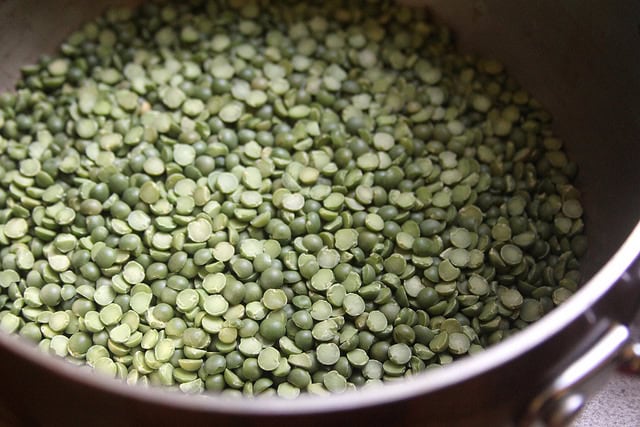It wouldn’t really be a soup if it were only one ingredient, right? That’s the thinking behind this weekend concoction where I deposed my growing stash of random root vegetables into a not-strictly-root-vegetable soup. By definition, soup is a mingling of stuff in liquid form, often creating a harmony of flavors that tickle your tastebuds as it soothes your soul. So do your kitchen a cleaning with this approach to your next winter soup.
Another reason to combine other stuff into a split pea soup? Because legumes (like peas and beans, and which the Brits call “pulses”) are an ancient, and everyday way to eat to better health. And if you thought you were alone with your New Year’s resolution, the Food and Agriculture Organization of the UN just named 2016 “The International Year of the Pulses,” because they’re awesome not only for the human body but for fixing nitrogen into soil, making it more fertile.

So I dunno. Playing around more with the culinary classics we’ve got for pulses—e.g. split-pea soup—seems like a good plan. Sure, you can make a lovely parsnip, celery root or rutabaga soup—or all three in one. But on that logic, you can make a lovely split pea soup with the kitchen sink, too (and ham optional).

So I diced up a carrot, small piece of celery root, and one parsnip, which were all castaways from Thanksgiving a few weeks back. Got a turnip? Fine. Don’t have a celery root? Add a celery stalk or two instead. I’d pass on potatoes here since split peas do add a fair amount of carbohydrates (like many dried legumes) as well as thickness to the soup, and potatoes would only add more of both, yet with less flavor than these sweet and savory root vegetables.

I trust you can figure out the rest. Or make this soup into something of your own, perhaps with spice blends or roasted garlic or smoked paprika. And on and on. Consider the legendary “stone soup” of lore: the more of the other stuff, the better.
Split Pea and Root Vegetable Soup
(makes about 6-8 servings)
3/4 cup split peas (either green or yellow)
1 small onion, diced
1 medium-sized carrot, peeled and diced
1 medium-sized parsnip, peeled and diced
1 small celery root (or celeriac), peeled and diced
2 cloves garlic, minced
4-5 cups chicken or vegetable stock (or turkey stock made with your leftover Thanksgiving bird)
3 tablespoons extra-virgin olive oil
salt and pepper to taste
Soak the peas in warm water to cover while you prepare and chop the rest of the ingredients. Heat 1 tablespoon of the olive oil in a large, lidded pot or Dutch oven. Add the onions and a pinch of salt and cook over low heat, stirring occasionally, until translucent (about 5-6 minutes).
Add the remaining 2 tablespoons of olive oil and the carrot, parsnip and celery root along with another pinch of salt and pepper. Cook on low, stirring occasionally, until vegetables are well softened, about 8-10 minutes. Add the garlic and cook and stir until fragrant, another 1-2 minutes.
Add the soaked split peas and the stock and increase heat to bring mixture just to a boil. Reduce heat to a low simmer and cover. Cook covered for 30-40 minutes. Using a hand blender, pulse the mixture several times until the consistency is smooth or just slightly chunky, depending on your preference (you can also work in batches with a food processor or blender for this). Season the soup to taste, and if desired, add more water or stock for a thinner consistency, or let simmer uncovered a while for a thicker consistency. Serve immediately, or keep for up to 1 week refrigerated.
Health Factor![]()
![]()
Two brownie points: It checks a lot of boxes—protein, fiber, potassium—for nutrients as well as buzzy labels—gluten-free, vegan, heart-healthy—for recipes. And it should fill you up as an entire meal. No regrets making a big pot of it.
Green Factor![]()
![]()
![]()
![]()
![]()
![]()
![]()
![]()
Eight brownie points: Using just dried pantry goods and winter vegetables, if you’ll allow a little imported olive oil, this recipe is a good, year-round low-carbon footprint dish. Extra point because eating more legumes, and hence increasing demand for farmers who grow it can help revitalize our soil (listen to my latest guest on Eat Your Words dish on the importance of carbon in soil).
5 Responses
Seana
The split pea soup looks wonderful I’m going to have to make it
Michael
Can I use my crock pot?
Cathy Erway
@Michael: Definitely!! Enjoy!
trump twitter
Pea soup seem look good. I really like it
Romas David
Great bit of info, I love reading other chicken enthusiasts posts and blogs, especially regarding the rare breeds. Great work!!!